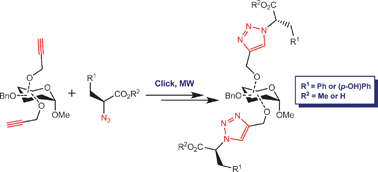Microwave-assisted construction of triazole-linked amino acid–glucoside conjugates as novel PTP1B inhibitors†
Abstract
There has been increasing interest in the development of

* Corresponding authors
a
PPSM, Institut d’Alembert, ENS de Cachan, CNRS UMR 8531, 61 Avenue du Pt Wilson, F-94235 Cachan, France
E-mail:
joanne.xie@ens-cachan.fr
Fax: +33 1-47402454
Tel: +331-47405586
b
Key Laboratory for Advanced Materials and Institute of Fine Chemicals, East China University of Science and Technology, 130 Meilong Road, Shanghai 200237, P. R. China
E-mail:
mrs_guorongchen@ecust.edu.cn
Fax: +86 21-64252758
Tel: +86 21-64253016
c School of Pharmacy, East China University of Science and Technology, 130 Meilong Road, Shanghai 200237, P. R. China
d
National Center for Drug Screening, State Key Laboratory of Drug Research, Shanghai Institute of Materia Medica, Chinese Academy of Sciences, Shanghai 201203, P. R. China
E-mail:
jli@mail.shcnc.ac.cn
Fax: +86 21-50800721
Tel: +86 21-50801552
There has been increasing interest in the development of

 Please wait while we load your content...
Something went wrong. Try again?
Please wait while we load your content...
Something went wrong. Try again?
X. He, C. Li, X. Jin, Z. Song, H. Zhang, C. Zhu, Q. Shen, W. Zhang, L. Sheng, X. Shi, Y. Tang, J. Li, G. Chen and J. Xie, New J. Chem., 2011, 35, 622 DOI: 10.1039/C0NJ00835D
To request permission to reproduce material from this article, please go to the Copyright Clearance Center request page.
If you are an author contributing to an RSC publication, you do not need to request permission provided correct acknowledgement is given.
If you are the author of this article, you do not need to request permission to reproduce figures and diagrams provided correct acknowledgement is given. If you want to reproduce the whole article in a third-party publication (excluding your thesis/dissertation for which permission is not required) please go to the Copyright Clearance Center request page.
Read more about how to correctly acknowledge RSC content.
 Fetching data from CrossRef.
Fetching data from CrossRef.
This may take some time to load.
Loading related content
